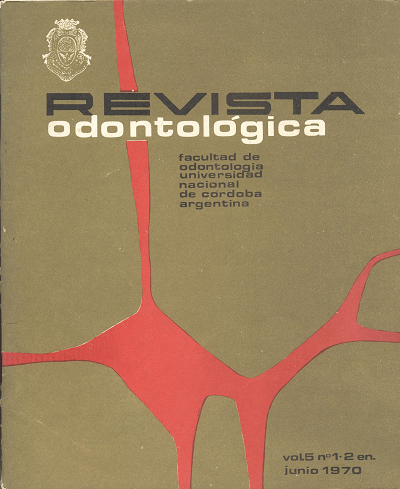Dureza de amalgamas dentales según las partículas y métodos de condensación
Keywords:
Dental Amalgam, CondensationAbstract
To objectify the variations in the hardness of amalgams with spheric particles and in filing amalgams by different methods of condensation, a) manual, b) mechanical and e) ultrasonic method, 90 test tubes w(thmechanical amalgamators were ma de. They were divided in 3 groups of 30 test tubes each, corresponding to the different particles and differentalloy trademarks used. They were all treated with the condensation methods above mentioned. The test tubes were filled and metalographically polished, measuring Vickers hardness making three indentations in each test tube, a) on the nucleus, b) on the middle of the radioe) on the surfaces. The figures obtained were tabulated and they underwent a cuantitative statistical analysis.
1) the hardness of hand condensed amalgams is less in filling amalgams and greater in spheric enes.
2) The hardness of the mechanically condensed amalgams is less in the filling amalgams and greater in the spheric ones.
3) The hardness produeed by the ultrasanie condensation is greater in the spherie amalgams and less in the 7ifling ones.
4) In comparing the hardnes of the same amalgam treated by the different eondensation methojs it is proved that, a) the hardness is greater under manual eondensation b) it is medium when mechanically eondensed and e) less under ultrasanie eondensation. ldentieal results
were obtained with the different types of alloys.
Downloads
Downloads
Issue
Section
License
Aquellos autores/as que tengan publicaciones con esta revista, aceptan los términos siguientes:
- Los autores/as conservarán sus derechos de autor y garantizarán a la revista el derecho de primera publicación de su obra, el cuál estará simultáneamente sujeto a la Licencia de reconocimiento de Creative Commons que permite a terceros:
- Compartir — copiar y redistribuir el material en cualquier medio o formato
- La licenciante no puede revocar estas libertades en tanto usted siga los términos de la licencia
- Los autores/as podrán adoptar otros acuerdos de licencia no exclusiva de distribución de la versión de la obra publicada (p. ej.: depositarla en un archivo telemático institucional o publicarla en un volumen monográfico) siempre que se indique la publicación inicial en esta revista.
- Se permite y recomienda a los autores/as difundir su obra a través de Internet (p. ej.: en archivos telemáticos institucionales o en su página web) después del su publicación en la revista, lo cual puede producir intercambios interesantes y aumentar las citas de la obra publicada. (Véase El efecto del acceso abierto).

